When it comes to heart health, understanding normal troponin levels is vital. These levels serve as crucial indicators of cardiac muscle injury. In today’s fast-paced world, with a rise in heart-related issues, knowing what these numbers mean can be a game-changer for you and your loved ones. Normal troponin levels typically range from less than 0.04 ng/mL to 0.2 ng/mL, depending on lab-specific assays. Let’s dive deeper into what these numbers signify and why they’re essential for understanding your heart health.

1. Defining Normal Troponin Levels and Their Significance
Troponin is a protein complex found in both cardiac and skeletal muscles. Its primary role is in muscle contraction, making it integral to heart function. But here’s the kicker: the measurement of troponin levels has emerged as one of the most reliable markers for identifying heart injuries, particularly in acute coronary syndrome.
Normal troponin levels indicate that your heart is functioning properly, while elevated levels can signal damage. In situations like heart attacks, even a slight increase can be significant. Therefore, understanding these levels can be a lifesaver.
In clinical practice, these values are interpreted with caution, taking into account patient-specific factors. It’s important to remember that a simple blood test can help prevent serious complications if you can catch potential issues early.

2. Analyzing Troponin Levels: Signs, Symptoms, and Diagnostic Implications
Alright, so let’s get real for a minute. Troponin levels are not just numbers thrown around in a doctor’s office; they’re pivotal for guiding decisions about treatment. Here are the signs and symptoms that require monitoring troponin levels:
a. Chest Pain
Chest pain is one of the most common reasons folks end up in the emergency room. If you show up with severe on-and-off chest pain, you can bet that troponin testing will be on the to-do list. Whether it’s stable angina or a full-blown myocardial infarction, troponin levels can provide immediate insights into cardiac distress.
b. Shortness of Breath
Let’s not forget shortness of breath. If you’re having trouble catching your breath, it could signal various cardiac conditions. Monitoring troponin levels can clarify what’s happening beneath the surface.
c. Risk Factors in Patients
Risk factors can steer your treatment path. High blood pressure, diabetes, and family history of heart disease all play a role. Understanding these factors not only contextualizes your normal troponin levels, but it also emphasizes the multifaceted approach needed in diagnosis and treatment.
3. The Interplay of Normal Troponin Levels with Other Key Biomarkers
Many health conditions can influence, or be influenced by, troponin levels. Let’s break down how normal troponin levels interact with other essential biomarkers.
a. Albumin Globulin Ratio
The albumin globulin ratio (A:G) is a crucial indicator of liver function and overall health. If abnormalities arise here, they might suggest systemic issues that could lead to higher troponin levels down the line. So, if you’re keeping tabs on your heart health, don’t overlook your A:G ratio!
b. Prolactin Levels and Cardiac Health
You might know prolactin for its role in reproductive health, but this hormone can also provide insights into your cardiovascular health. High prolactin levels have been linked to an increased risk of heart disease, making those troponin checkpoints even more critical during acute conditions.
c. Bilirubin in Urine’s Relevance
Bilirubin in urine might sound obscure, but it indicates liver issues that could worsen cardiac conditions. Monitoring these levels along with normal troponin levels can paint a more comprehensive picture of your health.
d. Creatinine Levels: High vs. Normal
Now let’s get a bit technical. Creatinine levels are markers of kidney function. High creatinine levels can indicate renal impairment and are often tied to cardiovascular risks. Understanding how elevated creatinine levels relate to troponin is essential to assess patient risk during cardiac events.
4. Real-World Application: Case Studies Linking Troponin Levels with Patient Outcomes
Let’s make this personal. Usually, numbers and tests get clinical pretty quick, but case studies can bring them alive.
a. Case Study: John, 52
Meet John, a 52-year-old male with a history of hypertension. He came in with elevated troponin levels of 0.5 ng/mL, coupled with high creatinine levels of 1.6 mg/dL. This scenario illustrates how understanding his normal troponin levels, alongside his kidney function, steered his treatment toward immediate intervention, potentially saving his life.
b. Case Study: Sarah, 30
Now, check out Sarah, a 30-year-old female with low troponin levels of 0.03 ng/mL. She presented with signs of stress-induced cardiomyopathy, all while her normal creatinine levels stood at 0.8 mg/dL. Case studies like Sarah’s emphasize how proper readings can delineate between cardiac event types and lead to appropriate treatment pathways.
5. Exploring Trends and Innovations in Troponin Testing
The future of heart health is bright! Recent advancements in biomarker technology are changing how physicians assess our cardiac health. New troponin assays emphasize faster, more accurate results. This development increases the opportunities for timely interventions that could save lives.
Moreover, integrating troponin testing with wearable technology opens exciting doors for proactive cardiac care. Imagine having real-time data on your heart health straight from your wrist!
Final Thoughts: The Evolving Landscape of Troponin Levels in Cardiac Health Management
As we step forward on the road to better heart health, understanding normal troponin levels becomes critically important. By examining how these levels interconnect with other biomarkers—like the albumin globulin ratio, prolactin levels, bilirubin in urine, and creatinine levels—we can deliver precise care. The innovations in testing create new opportunities for timely diagnostics, which ultimately leads to improved outcomes.
Remember, folks, your heart health matters. Whether you’re hitting the gym or just living your life, keep those normal troponin levels on your radar! Knowledge is power, and a healthy heart is the foundation of a strong and vibrant life. Embrace the path toward wellness and always stay informed!
Now level up, get shredded, gain muscle, and embrace your healthiest self! For more insights into health and wellness, check out our articles on Ozempic online, look into Ozempic savings cards, and be sure to explore our section on hemoglobin Tests to gauge your overall fitness progress.
Normal Troponin Levels: Trivia and Interesting Facts
Understanding Normal Troponin Levels
Did you know that the heart’s muscle cells release troponin into the bloodstream during injury? Understanding normal troponin levels is crucial for diagnosing heart problems. Typically, troponin levels below 0.04 ng/mL are considered normal, but these figures can vary slightly among laboratories. Coincidentally, speaking of variations, have you ever checked out the fascinating Casa Bonita menu? It reminds us that just as every restaurant has its specialties, each lab has its own guidelines for troponin readings.
Additionally, here’s a fun fact: troponin tests can take about 30 minutes to deliver results. If you’re curious about related timelines, check out how long does it take to get various medical tests done. Keeping track of your troponin levels can act like monitoring your playlists on an aux cord for iPhone; consistency is key, and you don’t want to skip the important checks!
The Role of Troponin in Heart Health
Troponin plays a pivotal role in heart health, acting as a signal for potential issues. When heart damage occurs, troponin levels rise significantly. This rise can be as noticeable as the latest hits starring Noomi Rapace in thrilling films. Similar to how her performances can capture an audience, sudden changes in troponin can catch a doctor’s attention and indicate a heart attack or other serious conditions.
Curiously, while many factors contribute to elevated troponin levels—like intense workouts or infections—it’s crucial to pay attention to what your body’s saying. And while you’re at it, consider elegant home decor items from Olive and Piper; just like keeping a tidy space helps maintain peace, understanding your health can lead to a more balanced life.
Importance of Regular Monitoring
Regularly monitoring your troponin levels can catch potential issues early. Just as Trevor Engelson knows timing is important in his projects, maintaining regular check-ups can make all the difference in heart health. When troponin levels stay elevated, it’s a signal to consult with a healthcare provider, making it essential to prioritize these tests alongside your routine health check-ups.
Ultimately, being informed about normal troponin levels allows individuals to take proactive steps in their health journeys. Just like exploring new menu items or engaging with the latest movies, educating oneself about heart health is a rewarding venture that pays off in the long run!



























